In every social media club, for every brand, there is a daily post asking “How much to install a new electrical panel for an EV charger?” The post is made by a prospective or new EV owner who may have just discovered that the electrical panel in the home is outdated and should be updated to accommodate the charging of electric vehicles. We add the plural “vehicles” because adding just one EV charger to a home is always a mistake if that home is expected to have more than one vehicle in the family fleet.
Related Story: Here Is Your Electric Vehicle Home Charger Checklist
Background - Who Is This Author?
I specializing in electric vehicle testing, evaluation, and “living electric” topics. I’ve fully tested, test-driven, or evaluated EVs from Tesla, Honda, Toyota, Chevrolet, Lincoln, Volvo, Kia, Nissan, Mitsubishi, BMW, Ford, and probably a few more brands I am forgetting. I’ve tested both generation Bolts, the Bolt EUV, Mustang Mach-E, Jeep Wrangler 4Xe, and many other new electrified models in 2021. I’m that guy who arrives at Tesla dealers in Kia Niro EVs and Mustang Mach-Es and then drives Model Y and Model 3 cars back to back to see how they compare and contrast. About 80% of my work is EV-related. This is my tenth year doing this work. I had an early start working with EVs. In the fifth year of my college engineering program, I opted to work with a team building a solar-electric vehicle. My role was to design the thermal management system of the battery pack. I earned an A-. That was 1990. In a nutshell, I’m an engineer by education and former employment and not an idiot who doesn’t understand EVs. I offer this because some commenters with differing opinions assume I’m “some sort of “dumb journalist who hates EVs.”
Related: Electric Vehicle Charging Is a Confusing Mess For New EV Owners
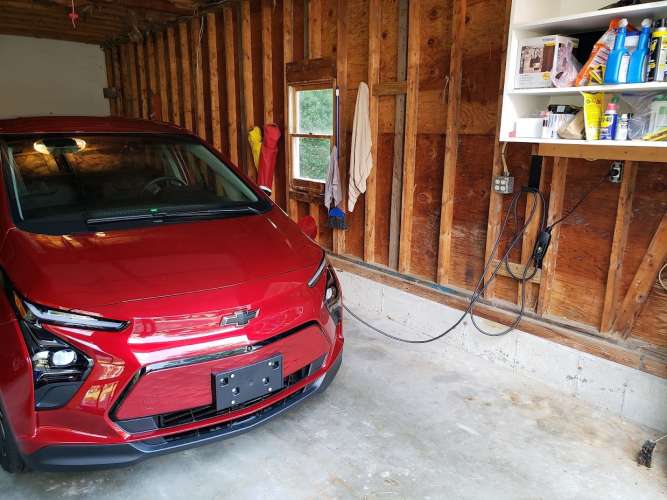
In my primary residence, my wife and I have an affordable and convenient Lectron charger (EVSE) we use with an existing NEMA 6-20R receptacle. We paid just $199 plus tax for it on Amazon. It works great. It adds back between 5 and 12 miles of range per hour on the charger depending on the vehicle and its state of charge. As part of my testing, I have charged EVs at DC fast chargers, and a long list of local and destination Level 2 chargers. You quickly learn important lessons when charging in public.
Related: Charging an Electric Vehicle In Public Can Cost Triple What Fueling Up a “Gas-Guzzler” Does
What’s With This Panel Update. Why Was It Needed?
My wife and I are fortunate to own a 600 square foot cabin in the woods in New England. Because I test EVs, and because the cabin is located in a charging desert in rural New England, I have a hard time managing the EVs I try to take there. The plug-in hybrid-electric vehicles (PHEVs) like the RAV4 Prime are brilliant for this. I charge them, drive about 100 miles to the cabin using up the EV range early in the trip, and then they become high-efficiency hybrids. Non-Tesla affordable battery-electric vehicles (BEVs) do not do well traveling to the cabin, driving around locally, and then heading back home. In winter they are entirely useless. Trust me, I’ve done the math. We have children, so I always need a vehicle I can drive back home in immediately if they need help. Many affordable BEVs simply cannot provide the range and flexibility I need/want in winter without being able to charge them on-site quickly.
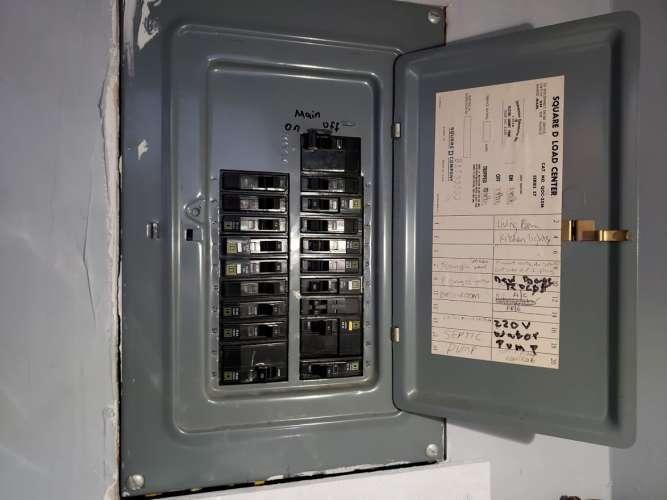
The cabin’s original wiring and panel were downright dangerous. Improperly-grounded circuits, locations near water without GFCI circuit protection, a water heater breaker literally sticking out of the wallboard. An electrical service mast that was rusted, bent, and questionable. And the little panel was full. We did use some mini-breakers to make space temporarily, but with the need for two EV circuits, one 240 V and one 120 V, plus future needs such as a possible mini-split heat pump and a baseboard heater or two, we needed to change the panel, update the entire setup and basically work backward from the pole to the house.
Who Was the Electrician?
My licensed and insured electrician is a person we have come to trust. He installed the controls and wiring for the septic system pump when we had that replaced. Shortly after it was installed the controls had an issue. He opened the tank, took proper precautions, entered the septic graywater tank, and fixed the hung-up float. And charged me nothing. It took a full day of work including the digging and troubleshooting. He also made safe the worst of the wiring immediately after we bought the cabin. His pricing was low. I base that on having remodeled multiple homes and rental properties. This is our second panel replacement project. We had one done in a home back in the 2000s.
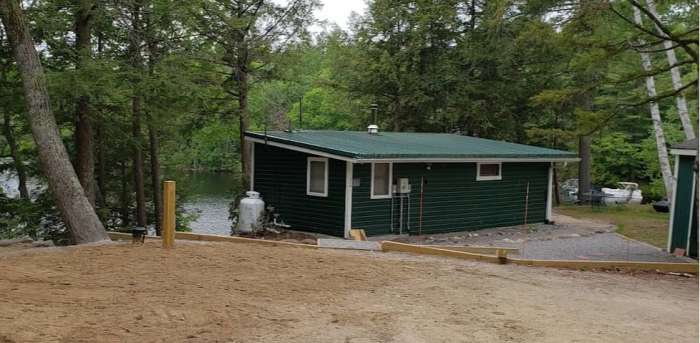
What Did We Do and Why?
Our plan was to add a charger point in the driveway. We cannot have a garage due to shoreline setbacks. When we installed the well it required a post to protect the wellhead from damage, and that doubled as a perfect mounting point for a pair of receptacles. We laid conduit in the ground when that project was done to prep for the future chargers.
Based on my EV testing experience, we opted to plan for two EV charger outlets. Since we’re not there often in winter, and since the private plows are operated by tired men in snowstorms at night, we want to be able to remove the EVSE (charger) in winter, but also put it back if we wanted to use it. Hence the option not to hard-wire the EVSE (charger). We will get something like a GRIZZL-E we can put out or take in as often as we need to. More and more, EVs are coming from the factory with EVSEs that can use a NEMA 14-50, so the GRIZZL-E may not even be needed if we buy one that comes with one (for example a Bolt EUV).
The primary EV charger outlet will be a 240V circuit with a 50A breaker on the code-mandated GFCI circuit (remember, it’s outdoors). This will be plenty to accommodate a BEV charging at a fast rate. The second will be a 120V 20A dedicated circuit with a three-prong receptacle for a second EV using its mobile charger. This is in case we want to allow neighbors or guests to charge, but not allow the use of our EV charger when we’re not on-site. We can leave the 20-amp 120V breaker on for them to trickle-charge their EV. It is also for instances in the future where both my wife and I may be in EVs. We don’t plan to ever buy another vehicle without a plug, be it PHEV, EREV, or BEV. We came danger-close to leasing a new 1st-gen Bolt this past spring but held off for a variety of reasons related to our existing fleet. I can see us owning a RAV4 Prime, ID.4 AWD, or possibly a Bolt EUV next. Maybe two of the three.
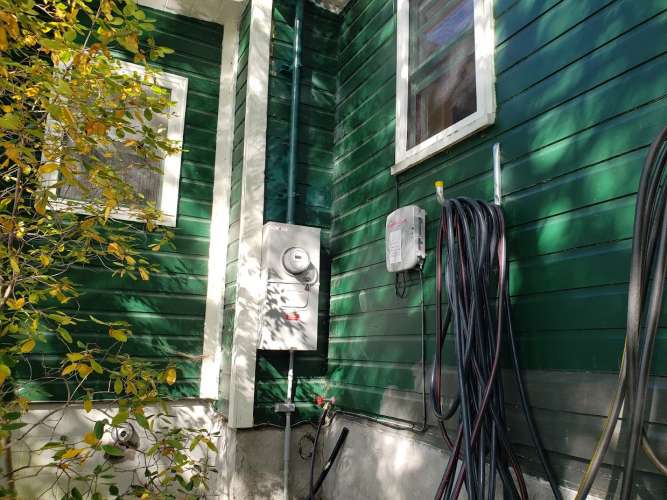
The Punchlist
Think of this project from the pole to the house. The electric utility (Eversource), at its own cost, ran a new line from the pole to the cabin. Our electrician changed the mast (the pole the wires are fixed to and enter into), the utility changed the meter in conjunction with my electrician, and we had to move the TDS Internet Service Provider equipment to satisfy Eversource’s distance requirements. This is all before we began the panel work. It involved three contractors. It took two business days.
Making It As Safe As Possible
We pulled a town building permit in advance of the project. We wanted the work done not just to code, but if any pending code changes were coming, to also satisfy those. One aspect of this is using arc-fault-ground-fault AFCI/GFCI breakers on nearly every circuit. Mice, chipmunks, red and gray squirrels are a big issue for any cabin owner. They love to chew wires. AFCIs can save a cabin from burning down from shorts caused by mice-eaten wires. Lightning surges are also an issue and the new whole-house surge protector may help with that. We use local surge protection on everything practical in addition.

It’s Never “Just” a New Panel
The work required two new grounding rods and new proper plumbing-related ground. Also, code required an external shut-off. The inside part of the project entailed not just changing the panel, but also minor carpentry because the new panel was way huger than the old one. The mast project required painting, patching of the woodwork on the exterior, and minor roof work around the new mast. We have a handyman doing some of that non-electrical work, the electrician did some, and I did some myself.
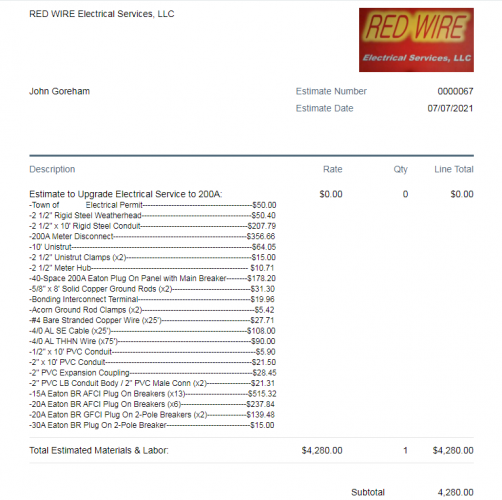
The EV Panel and Service Replacement Price Tag
Although this project was primarily to enable EV charging, it was not solely for that reason. For example, we also wanted a whole-house surge protection system and space for future upgrades. Not including some re-wiring we did just to make the cabin safer after we bought it, we budgeted $5K for the panel replacement and service upgrade. The original quote was $4,300 for the panel and some of the work, but we added some requests and we installed some extra Eaton breakers in advance of future needs. The total cost of the electrician’s time and materials was $5,336. Add in about $200 more for handyman, permits, and the $60 TDS service fee for them to move the ISP box. The conduit cost to the outside pole was part of the well project. Figure $300. The wiring to the EV receptacles will be about $ 300 more by my estimation. The project took a working week. All-in, the project is about $6K.
Conclusion - Benefits and Did We really “Spend” Any Money?
The upshot of this work is that the cabin will have two receptacles for EV charging this spring. We are holding off on those circuits until after winter because we want to make certain the snowplows don’t hit the mounting point we plan to use. We can also rest easier knowing the house is as electrocution-resistant and fire-resistant as it can be. We bought our cabin pre-COVID. Since then, we have had multiple unsolicited requests to buy it for a lot more than we paid. Cabins on the lake sell the morning they are listed, usually for cash. Our seasonal cabin is now electrically enabled to be an all-season home. One way of thinking about this upgrade is that we added equity to the property. Although EVs are not popular in New Hampshire yet, they sure are popular among the residents of Massachusetts and Connecticut who own cabins in our area.
Post -Script - My Opinions
I’m an EV realist, not an idealist. I try not to preach or advocate for EVs, but to educate. One area I feel many EV fans become a bit blinded by advocacy is the idea that EV charging is simple. My experience is that it is not simple. Maybe someday it will be. At our cabin, it will be. That we know.
John Goreham is a long-time New England Motor Press Association member and recovering engineer. John's interest in EVs goes back to 1990 when he designed the thermal control system for an EV battery as part of an academic team. After earning his mechanical engineering degree, John completed a marketing program at Northeastern University and worked with automotive component manufacturers, in the semiconductor industry, and in biotech. In addition to Torque News, John's work has appeared in print in dozens of American news outlets and he provides reviews to many vehicle shopping sites. You can follow John on TikTok @ToknCars, on Twitter, and view his credentials at Linkedin
Re-Publication. If you wish to re-use this content, please contact Torque News for terms and conditions.



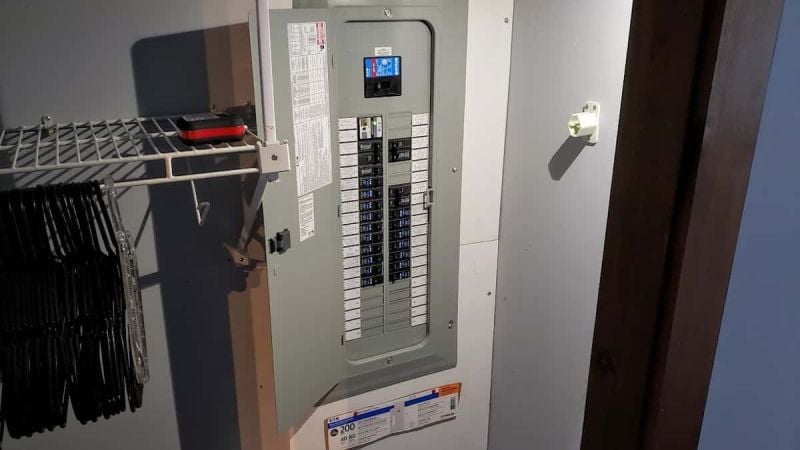









Comments
Its not my first time to go…
Permalink
Its not my first time to go to see this site i am visiting this website dailly and get nice facts from here daily.